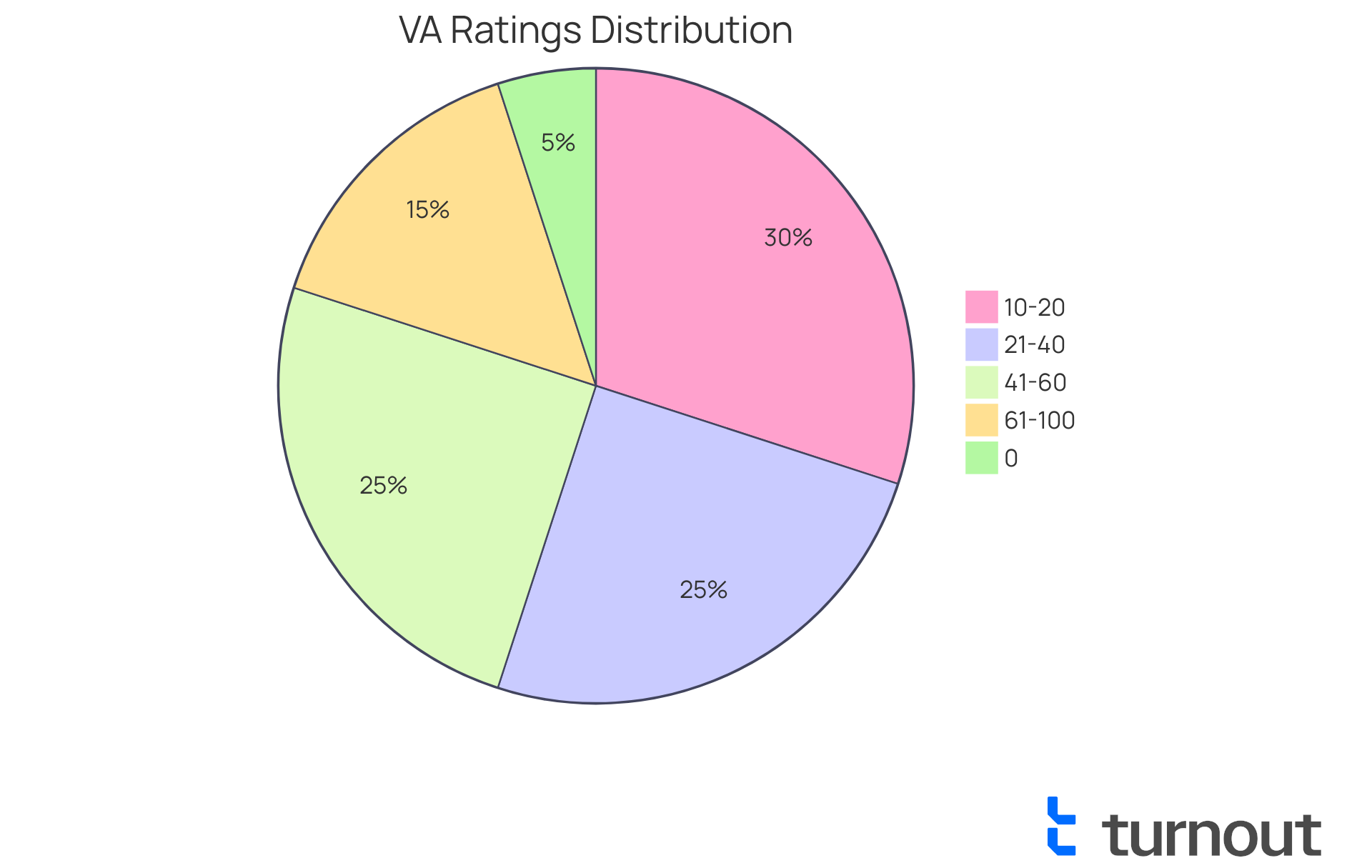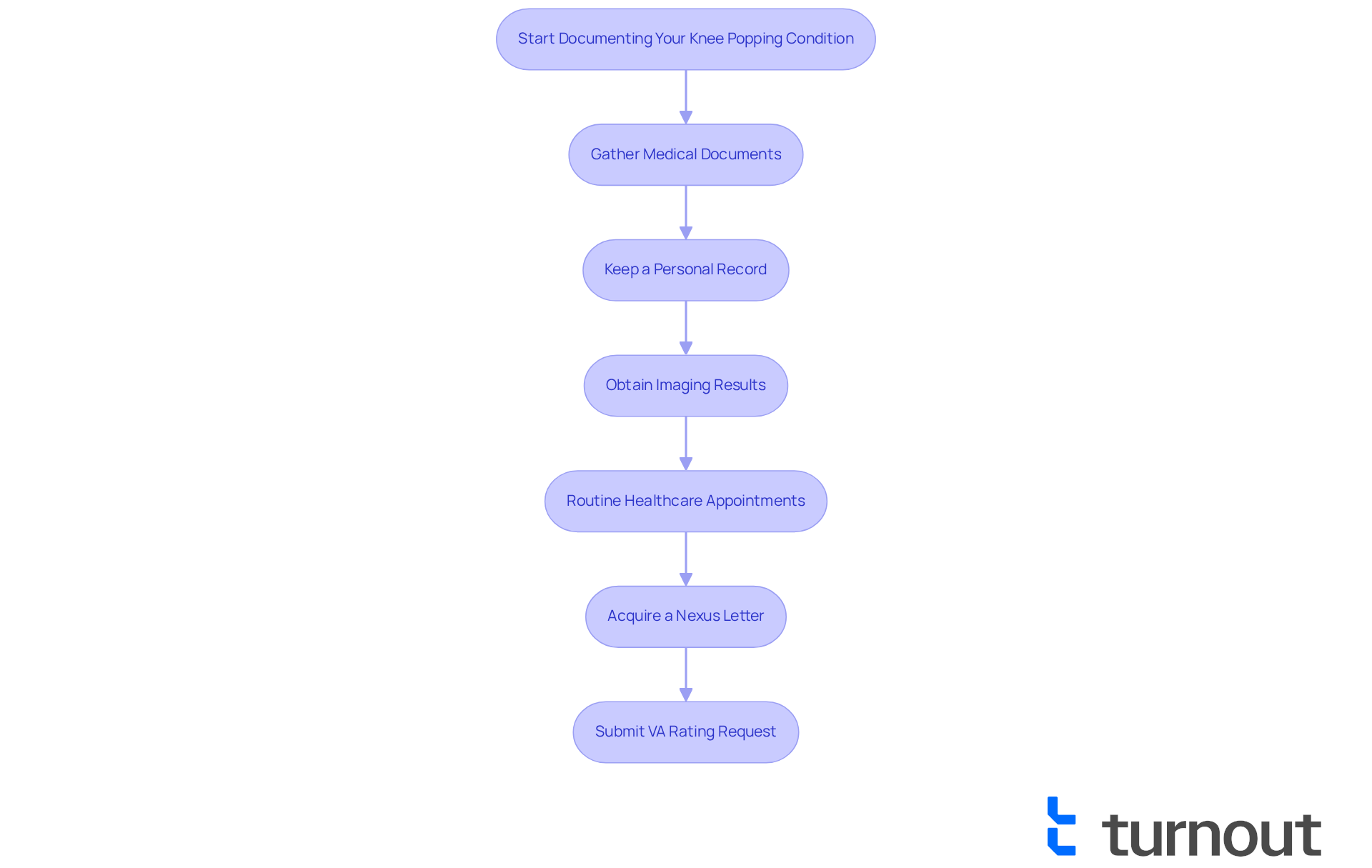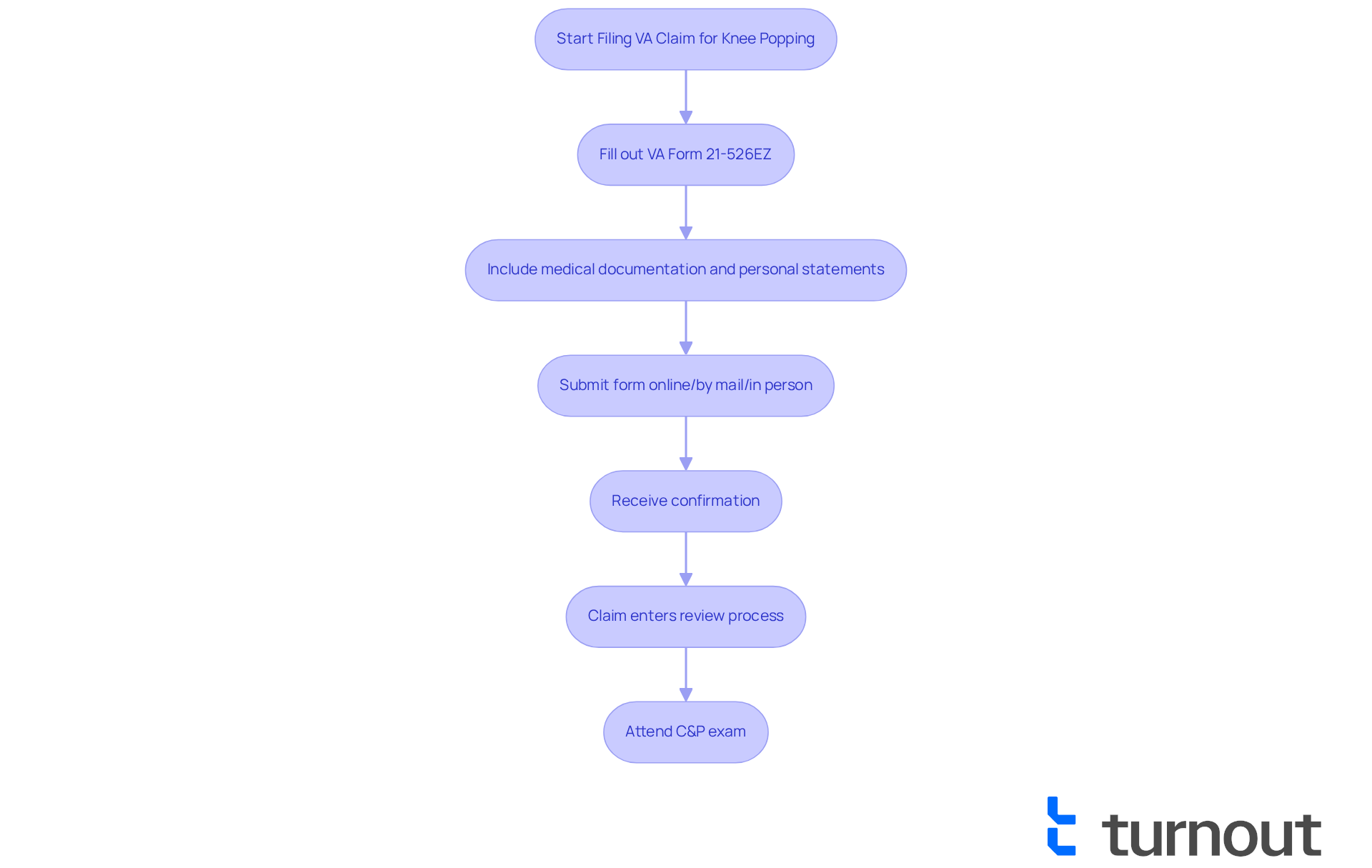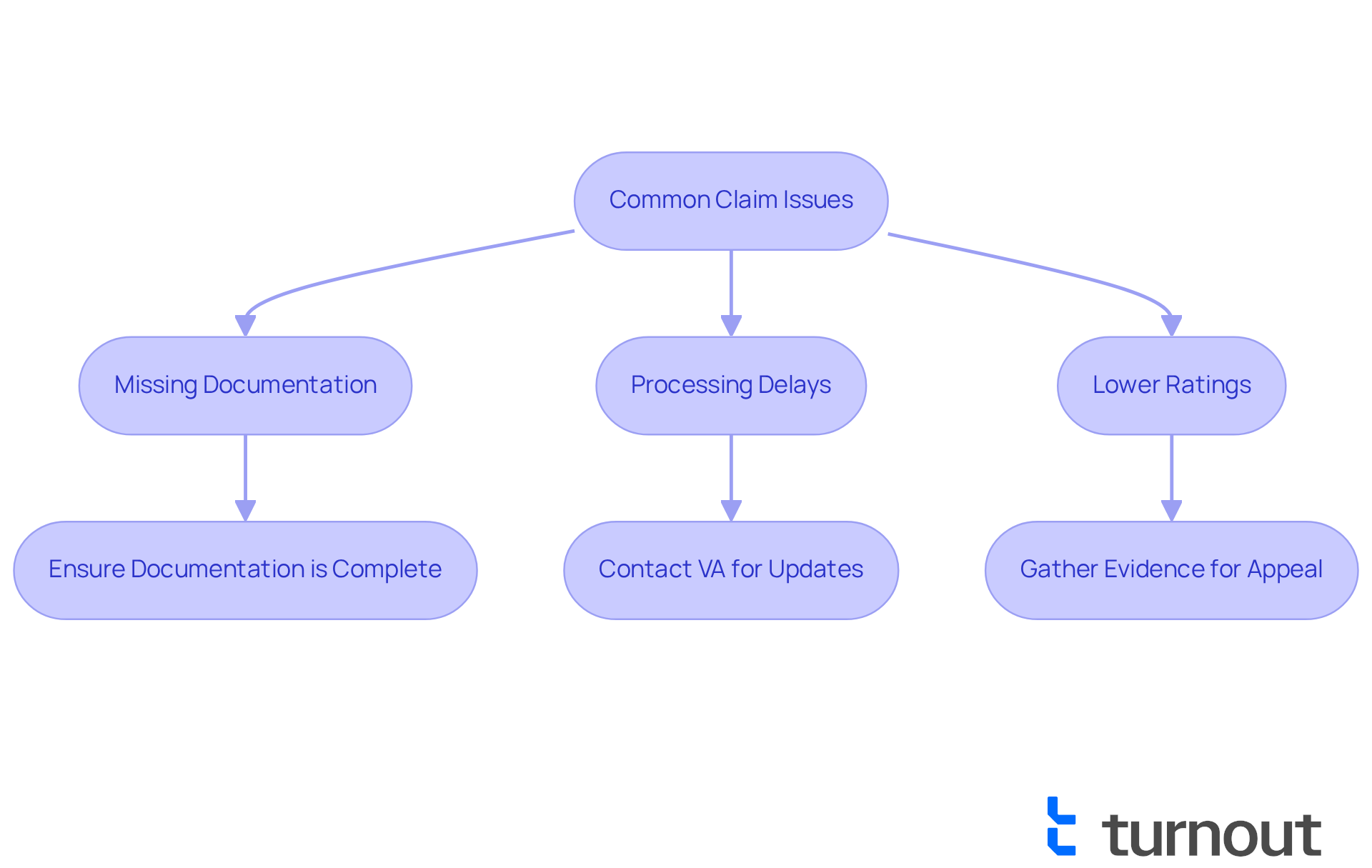Overview
This article serves as a caring guide, offering a comprehensive step-by-step approach to mastering the VA rating process for knee popping. We understand that navigating this process can be daunting, and we emphasize the importance of thorough documentation and a clear understanding of the evaluation criteria. By detailing the factors that influence ratings—such as the severity of symptoms and their impact on daily life—we aim to provide you with the reassurance and support you need. Additionally, we offer practical advice on filing claims and addressing common challenges faced by veterans, ensuring that you feel empowered throughout this journey.
Introduction
Understanding the complexities of VA ratings for knee conditions can feel overwhelming. We recognize that many veterans are grappling with the significant impacts of joint issues on their daily lives. The VA evaluates these conditions based on severity and functional limitations, with ratings that can greatly influence the support you receive. Yet, navigating the claims process can be challenging. How can you ensure that you accurately document your knee popping conditions and maximize your benefits?
This guide offers a step-by-step approach to mastering the VA rating process. We’re here to empower you to advocate effectively for the compensation you deserve. You are not alone in this journey; together, we can navigate these complexities.
Understand VA Ratings for Knee Conditions
The VA allocates disability evaluations, including the [VA rating for knee popping](https://myturnout.com/why-turnout), for joint issues based on the severity of the ailment and its impact on daily activities. Scores can range from 0% to 100%, with typical scores for joint problems generally falling between 10% and 60%. Factors such as restricted motion, instability, or persistent pain can significantly influence the assessment. Understanding the VA rating for knee popping is essential; it details specific diagnostic codes, like DC 5256 for unfavorable ankylosis and DC 5257 for joint impairment, along with the corresponding evaluations for various joint issues. By grasping these evaluations, you can better assess your situation and prepare for the claims process effectively.
Many veterans express that joint pain from service-related injuries can profoundly affect their daily lives. For instance, one veteran who experienced instability due to a meniscus tear obtained a 20% disability assessment by demonstrating how the condition impacted their mobility and daily tasks. Similarly, another veteran, initially evaluated at 50%, successfully contested for a higher rating by providing comprehensive medical records linking their leg discomfort to service-related activities.
Statistics show that a significant number of veterans receive disability evaluations for joint problems, particularly a VA rating for knee popping, with many falling within the 10% to 60% range. This underscores the importance of accurately documenting symptoms and their effects on daily functioning. Advocates emphasize that understanding how the VA rating for knee popping and other joint issues is crucial for obtaining appropriate disability compensation, as the severity of each ailment and its impact on life can lead to different ratings. By gathering thorough medical records and service-related documentation, veterans can strengthen their claims and improve their chances of receiving the benefits they deserve.
We understand that navigating this process can be overwhelming, but remember, you are not alone in this journey. We're here to help you every step of the way.

Document Your Knee Popping Condition
To effectively address your joint popping issue, we understand that starting can feel overwhelming, especially when considering the VA rating for knee popping. Begin by gathering all pertinent medical documents, including:
- Diagnoses
- Treatment plans
- Notes from your healthcare providers that detail your symptoms
Additionally, consider keeping a personal record of your joint's state. Document occurrences of popping, pain levels, and how these factors affect your VA rating for knee popping and your daily activities. If possible, acquire imaging results like X-rays or MRIs that visually illustrate your joint's condition.
This thorough documentation will be essential for the VA rating for knee popping when submitting your request. It provides the VA with a clear understanding of your joint issue and its effects on your life, as well as the VA rating for knee popping. Routine healthcare appointments are crucial for maintaining an ongoing record that supports your disability rating. Remember, interruptions in treatment may lead the VA to believe your status has improved.
Moreover, obtaining a Nexus letter that connects your joint issue to your military service can significantly enhance your application. Consider utilizing Disability Benefits Questionnaires (DBQs) to document your condition in a format that aligns with VA requirements, potentially expediting the approval process.
It's important to note that approximately 80% of veterans are underrated by the VA. Therefore, thorough and accurate documentation is vital to improve your chances of receiving the benefits you deserve. Remember, you're not alone in this journey; we're here to help you navigate through it.

File Your VA Claim for Knee Popping
If you're looking to submit your VA rating for knee popping, we understand that this can be a challenging process. Start by filling out VA Form 21-526EZ, which is the application for disability compensation. It's important to include all relevant medical documentation and personal statements that support your claim. Once you have completed the form, you can submit it online through the VA's website, by mail, or in person at your local VA office.
After you submit your request, you will receive a confirmation, and your claim will enter the VA's review process. It's common to feel anxious during this time, but rest assured that you are taking important steps forward. Be prepared to attend a Compensation and Pension (C&P) exam, where a VA representative will assess your knee condition. This exam is essential for determining your disability classification, so please be honest and thorough in describing your symptoms. Remember, we're here to help you through this journey.

Troubleshoot Common Claim Issues
Navigating the VA application process can be challenging, and it's common to encounter issues such as:
We understand that these hurdles can be frustrating. To tackle these challenges, start by ensuring that all your documentation is complete and submitted correctly. If you find yourself facing delays, consider reaching out to the VA to check on the progress of your request.
As of 2025, many veterans are experiencing longer wait times, with averages exceeding 125 days for a decision. Yet, there is a silver lining: the VA is processing requests 17.8% faster in FY25 compared to FY24, which may provide some hope. If your request is denied or if you disagree with the rating, remember that you have the right to contest the decision. It’s essential to gather comprehensive evidence, including:
- Medical records
- Layman statements
As these can significantly bolster your appeal.
Connecting with veteran service organizations, like Soldiers' Angels, can offer you additional support and resources to navigate the complexities of the application process. Staying proactive and informed throughout this journey will empower you to effectively address any challenges that arise. Remember, as Thomas Pamperin wisely stated, the claims process doesn’t need to be a hassle. Maintaining ongoing medical treatment is crucial for demonstrating the persistence and severity of your disability. You are not alone in this journey, and we’re here to help.

Conclusion
Understanding the VA rating for knee popping is essential for veterans seeking the benefits they deserve. We recognize that navigating this process can be overwhelming. This guide highlights the importance of accurately documenting symptoms, the steps for filing a claim, and the potential challenges you may encounter along the way.
By grasping the intricacies of the VA rating system and taking proactive steps, you can significantly enhance your chances of obtaining the appropriate disability compensation. Key insights include:
- The need for thorough medical documentation
- The significance of personal records detailing how knee conditions impact your daily life
It's crucial to connect these issues to your military service.
We understand that persistence is vital in navigating the claims process. Seeking support from veteran service organizations can also make a substantial difference. Remember, you are not alone in this journey.
Ultimately, we encourage you to take charge of your claims by ensuring all documentation is complete and up-to-date. The journey may seem daunting, but with the right information and support, securing the benefits related to knee popping and other service-connected conditions is within your reach. Taking these steps not only aids in your recovery but also empowers you to advocate for your rights and well-being effectively.
Frequently Asked Questions
What is the VA rating for knee conditions based on?
The VA rating for knee conditions is based on the severity of the ailment and its impact on daily activities, with scores ranging from 0% to 100%.
What factors influence the VA rating for knee popping?
Factors that influence the VA rating for knee popping include restricted motion, instability, and persistent pain.
What are some specific diagnostic codes related to knee conditions?
Specific diagnostic codes include DC 5256 for unfavorable ankylosis and DC 5257 for joint impairment, each associated with different evaluations for joint issues.
What is the typical range for VA ratings for joint problems?
The typical range for VA ratings for joint problems generally falls between 10% and 60%.
How can veterans strengthen their claims for knee-related disabilities?
Veterans can strengthen their claims by accurately documenting symptoms, providing comprehensive medical records, and linking their conditions to service-related activities.
Can veterans contest their initial disability evaluations?
Yes, veterans can contest their initial disability evaluations by presenting additional evidence that demonstrates the impact of their condition on their daily lives.
Why is it important to understand the VA rating for knee popping?
Understanding the VA rating for knee popping is crucial for obtaining appropriate disability compensation, as it helps veterans assess their situation and prepare effectively for the claims process.
What support is available for veterans navigating the VA claims process?
Veterans can find support throughout the claims process, as there are resources and advocates available to assist them every step of the way.




